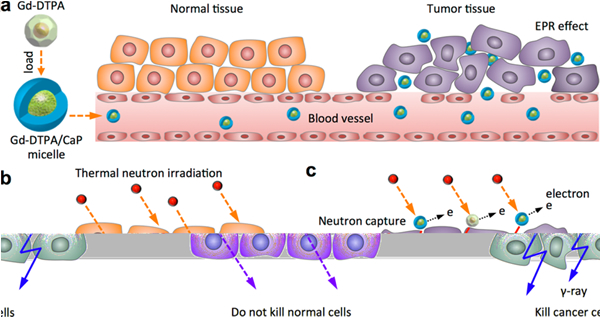Research Highlights
Vol.5, October 2015
Gadolinium-based particles show and treat tumours
Neutron-capture therapy (NCT) provides an effective localised treatment for irradiating cancer tumours. However to ensure only cancerous cells are destroyed it is helpful to see where NCT drugs have accumulated in order to target their activation only in tumours.
Now a collaboration led by researchers at the Kawasaki Institute of Industry Promotion in Japan has demonstrated cancer imaging and treatment using gadolinium-based nanoparticles in living mice.
Absorption of harmless low-energy thermal neutrons can trigger fission in stable elements including lithium, boron, gadolinium and uranium, releasing high-energy particles and gamma radiation that destroy nearby cells. Therefore, NCT has the potential advantage of attacking cells across a whole tumour. Among those elements, gadolinium is useful, because is used for MRI imaging.
Dr. Kazunori Kataoka and colleagues at Kawasaki Institute of Industry Promotion, Tokyo Institute of Technology, The University of Tokyo, National Institute of Radiological Sciences and Kyoto University in Japan delivered a gadolinium-based clinical MRI contrast agent - Gd-DTPA - to tumour cells. They encased the drug in CaP micelles that ensured preferential uptake by tumour tissue and stayed intact while in the blood only disintegrating to release the gadolinium compounds once in tumour cells in response to the change in pH.
“The Gd-DTPA/CaP showed a dramatically increased accumulation of Gd-DTPA in tumours, leading to the selective contrast enhancement of tumour tissues for precise tumor location by MRI,” state the researchers in their report. “The enhanced tumour-to-blood distribution ratio of Gd-DTPA/CaP resulted in the effective suppression of tumour growth without loss of body weight, indicating the potential of Gd-DTPA/CaP for safe cancer treatment.”
Publication and Affiliation
Peng Mi,1,2,3 Novriana Dewi,4 Hironobu Yanagie,4 Daisuke Kokuryo,5 Minoru Suzuki,6 Yoshinori Sakurai,6 Yanmin Li,7 Ichio Aoki,5 Koji Ono,6 Hiroyuki Takahashi,4 Horacio Cabral,7 Nobuhiro Nishiyama,*,1,2 and Kazunori Kataoka*1,3,7,8 Hybrid calcium phosphate-polymeric micelles incorporating gadolinium chelates for imaging-guided gadolinium neutron capture tumor therapy. ACS Nano, 9, 5913–5921, (2015).
- Innovation Center of Nanomedicine, Kawasaki Institute of Industry Promotion, 66-20 Horikawa-cho, Saiwai-ku, Kawasaki 212-0013, Japan
- Polymer Chemistry Division, Chemical Resources Laboratory, Tokyo Institute of Technology, R1-11, 4259 Nagatsuta, Midori-ku, Yokohama 226-8503, Japan
- Center for Disease Biology and Integrative Medicine, Graduate School of Medicine, The University of Tokyo, 7-3-1 Hongo, Bunkyo-ku, Tokyo 113-8656, Japan
- Department of Nuclear Engineering and Management, Graduate School of Engineering, The University of Tokyo, 7-3-1 Hongo, Bunkyo-ku, Tokyo 113-8656, Japan
- Molecular Imaging Center, National Institute of Radiological Sciences, Anagawa 4-9-1, Inage, Chiba, 263-8555, Japan
- Research Reactor Institute, Kyoto University, Asahiro nishi, Kumatori-cho, Sennan-gun, Osaka 590-0494, Japan
- Department of Bioengineering, Graduate School of Engineering, The University of Tokyo, 7-3-1 Hongo, Bunkyo-ku, Tokyo 113-8656, Japan
- Department of Materials Engineering, Graduate School of Engineering, The University of Tokyo, 7-3-1 Hongo, Bunkyo-ku, Tokyo 113-8656, Japan
*corresponding author, e-mail address: nishiyama@res.titech.ac.jp, kataoka@bmw.t.u-tokyo.ac.jp.
Figure:







